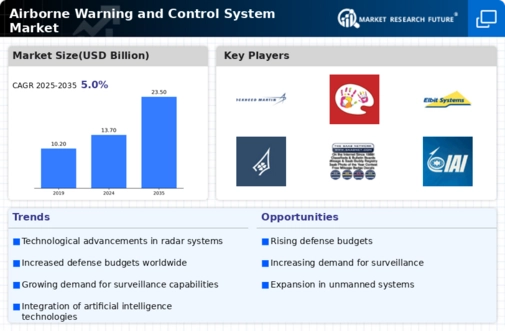Technological Innovations
Technological innovations play a pivotal role in shaping the Airborne Warning and Control System Market. The integration of cutting-edge technologies such as artificial intelligence, machine learning, and advanced radar systems is revolutionizing the capabilities of airborne warning systems. These innovations enable enhanced data processing, improved target detection, and more efficient communication between platforms. As a result, military forces are increasingly adopting these advanced systems to maintain a strategic edge. The market is expected to witness substantial growth, with projections indicating a compound annual growth rate of around 6% over the next five years. This growth is indicative of the ongoing evolution within the Airborne Warning and Control System Market, driven by the need for more sophisticated and reliable defense solutions.
Increasing Defense Budgets
The Airborne Warning and Control System Market is experiencing a notable surge in demand, primarily driven by increasing defense budgets across various nations. Countries are prioritizing the enhancement of their military capabilities, leading to substantial investments in advanced surveillance and reconnaissance systems. For instance, defense budgets in regions such as Asia-Pacific and Europe have seen a consistent rise, with some nations allocating over 2% of their GDP to defense spending. This trend indicates a growing recognition of the importance of air superiority and situational awareness in modern warfare. Consequently, the Airborne Warning and Control System Market is poised for growth as governments seek to procure sophisticated systems that can provide real-time intelligence and enhance operational effectiveness.
Rising Threats and Security Concerns
The Airborne Warning and Control System Market is significantly influenced by the rising threats and security concerns faced by nations worldwide. The proliferation of asymmetric warfare, cyber threats, and regional conflicts has prompted countries to bolster their defense mechanisms. As a result, there is an increasing emphasis on acquiring advanced airborne surveillance systems that can detect and neutralize potential threats. The market is projected to grow as nations invest in technologies that enhance their situational awareness and response capabilities. For example, the demand for airborne early warning systems is expected to rise, with estimates suggesting a market growth rate of approximately 5% annually over the next decade. This trend underscores the critical role of the Airborne Warning and Control System Market in addressing contemporary security challenges.
Strategic Alliances and Partnerships
Strategic alliances and partnerships are emerging as a key driver within the Airborne Warning and Control System Market. Collaborations between defense contractors, technology firms, and government agencies are fostering innovation and accelerating the development of advanced airborne systems. These partnerships facilitate the sharing of resources, expertise, and technology, ultimately leading to the creation of more effective and efficient systems. For instance, joint ventures between leading defense manufacturers have resulted in the successful deployment of next-generation airborne warning systems. This collaborative approach not only enhances product offerings but also expands market reach. As the demand for sophisticated airborne systems continues to rise, the Airborne Warning and Control System Market is likely to benefit from these strategic collaborations.
Growing Demand for Multi-Domain Operations
The growing demand for multi-domain operations is significantly impacting the Airborne Warning and Control System Market. Military strategies are increasingly focusing on the integration of air, land, sea, and cyber domains to achieve operational superiority. This shift necessitates the development of advanced airborne warning systems capable of providing comprehensive situational awareness across multiple domains. As a result, defense forces are investing in systems that can seamlessly operate in joint environments, enhancing their ability to respond to complex threats. The market is projected to expand as nations seek to modernize their capabilities to support multi-domain operations. Analysts suggest that this trend could lead to a market growth rate of approximately 7% over the next few years, highlighting the critical role of the Airborne Warning and Control System Market in future military operations.


















Leave a Comment